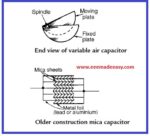1. Active materials of a lead-acid cell are :
(a) lead peroxide (b) sponge lead
(c) dilute sulphuric acid (d) all the above
2. During the charging of a lead-acid cell :
(a) its cathode becomes dark chocolate brown
in colour
(b) its voltage increases
(c) it gives out energy
(d) specific gravity of H2SO4 is decreased
3. The ratio of Ah efficiency to Wh efficiency of a
lead-acid cell is :
(a) always less than one (b) just one
(c) always greater than one
(d) either (a) or (b)
4. The capacity of a cell is measured in :
(a) watt-hours (b) watts
(c) amperes (d) ampere-hours
5. The capacity of a lead-acid cell does NOT
depend on its :
(a) rate of charge
(b) rate of discharge
(c) temperature
(d) quantity of active material
6. As compared to constant-current system, the
constant-voltage system of charging a lead-acid
cell has the advantage of :
(a) avoiding excessive gassing
(b) reducing time of charging
(c) increasing cell capacity
(d) both (b) and (c).
7. Sulphation in a lead-acid battery occurs due to:
(a) trickle charging
(b) incomplete charging
(c) heavy discharging (d) fast charging
8. The active materials of a nickel-iron battery are.
(a) nickel hydroxide
(b) powdered iron and its oxides
(c) 21% solution of caustic potash
(d) all of the above.
9. During the charging and discharging of a nickel
iron cell :
(a) its e.m.f. remains constant
(b) water is neither formed nor absorbed
(c) corrosive fumes are produced
(d) nickel hydroxide remains unsplit
10. As compared to a lead-acid cell, the efficiency
of a nickel-iron cell is less due to its :
(a) lower e.m.f.
(b) smaller quantity of electrolyte used
(c) higher internal resistance
(d) compactness.
11. Trickle charging of a storage battery helps to :
(a) prevent sulphation
(b) keep it fresh and fully charged
(c) maintain proper electrolyte level
(d) increase its reserve capacity
12. A dead storage battery can be revived by :
(a) a dose of H2SO4
(b) adding so-called battery restorer
(c) adding distilled water
(d) none of the above
13. The sediment which accumulates at the bottom
of a lead-acid battery consists largely of :
(a) lead-peroxide (b) lead-sulphate
(c) antimony-lead alloy (d) graphite
14. The reduction of battery capacity at high rates
of discharge is primarily due to :
(a) increase in its internal resistance
(b) decrease in its terminal voltage
(c) rapid formation of PbSO4 on the plates
(d) non-diffusion of acid to the inside active
materials.
15. Floating battery systems are widely used for :
(a) power stations
(b) emergency lighting
(c) telephone exchange installation
(d) all of the above
16. Any charge given to the battery when taken off
the vehicle is called :
(a) bench charge (b) step charge
(c) float charge (d) trickle charge
ANSWERS
1. d 2. b 3. c 4. d 5. a 6. d 7. b 8. d 9. b 10. c 11. b 12. d 13. c 14. c 15. d 16. a
Read also
Cells and Batteries
nickel is released from ____ ?
- Environment MCQ for RRB JE CBT 2|Objective Questions Environment for Competitive Exams
- RRB JE CBT 2 Computer Awareness Book Arihant|Objective Computer Awareness Book 2025
- RRB JE CBT 2 Exam Date 2025 Postponed|RRB JE CBT 2 Exam Date
- [PDF]RRB JE Result 03/2024 Cut off, Selected no of candidates for all regions
- [PDF]Final Answer Key Junior Instructor Mechanic Agricultural Machinery|643/2023 Solved Question paper
- Environment MCQ for RRB JE CBT 2|Objective Questions Environment for Competitive Exams
- RRB JE CBT 2 Computer Awareness Book Arihant|Objective Computer Awareness Book 2025
- RRB JE CBT 2 Exam Date 2025 Postponed|RRB JE CBT 2 Exam Date
- [PDF]RRB JE Result 03/2024 Cut off, Selected no of candidates for all regions
- [PDF]Final Answer Key Junior Instructor Mechanic Agricultural Machinery|643/2023 Solved Question paper
- Acoustics MCQs|Industries Extension officer|IEO 2025
- LASER MCQs| Industries Extension officer|IEO 2025
- Practical Types of Capacitors
- [PDF] Syllabus JUNIOR INSTRUCTOR MECHANIC AGRICULTURAL MACHINERY|643/2023 Syllabus Kerala PSC
- [PDF] Syllabus JUNIOR INSTRUCTOR WOOD WORK TECHNICIAN|674/2023 Syllabus Kerala PSC
- [PDF] Syllabus JUNIOR INSTRUCTOR MECHANIC CONSUMER ELECTRONIC APPLIANCES|670/2023 Syllabus Kerala PSC
- [PDF] Junior Instructor Hospital Housekeeping| 646/2023 syllabus Kerala PSC
| Basic Electrical Engineering MCQ’s From Notebook Site (www.notebukofaprofessor.blogspot.com) |
| 1. Basic Electrical Engineering MCQ 1 |
| 2. Current Electricity MCQ |
| 3. Basic Electrical MCQ 2 |
| 4. Basic Electrical Engineering MCQ 3 |
| 5. Basic Electrical Engineering MCQ 4 |
| 6. Basic Electrical Engineering MCQ 5 |
| 7. Basic Electrical Engineering MCQ 6 |
| 8. Basic Electrical Engineering MCQ 7 |
| 9. Basic Electrical Engineering MCQ 8 |
| 10. Basic Electrical Engineering MCQ 9 |
| 11. Basic Electrical Engineering MCQ 10 |
| 12. Basic Electrical Engineering MCQ 11 |
| 13. Basic Electrical Engineering MCQ 2 |
| 14. Basic Electrical Engineering MCQ 14 |








